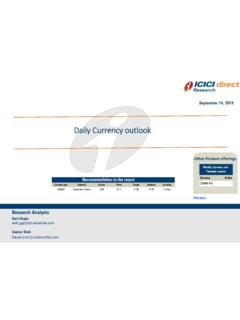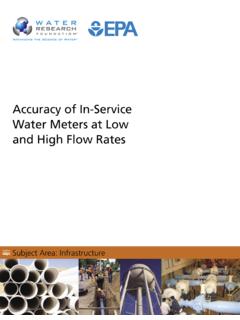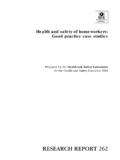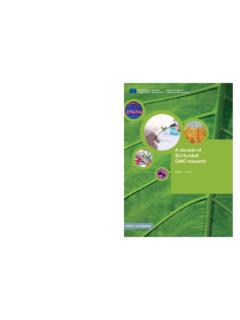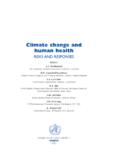Transcription of Beyond Proof - UNHCR
1 Beyond ProofCredibility Assessment in EU Asylum SystemsEuropean Refugee Fund of the European CommissionMay 2013 Beyond ProofCredibility Assessment in EU Asylum SystemsEuropean Refugee Fund of the European CommissionMay 2013 AcknowledgementsThe Project Coordinator for the report was Clara Odofin. The National Project Researchers, Mieke Verrelst (Belgium), Karen Geertsema and Hannah Helmink (Netherlands), and Mohbuba Choudhury (UK), are thanked for their contributions. Michael Andrew Ross is also thanked for his preparation of the checklists annexed to this is sincerely grateful for the cooperation of the national asylum authorities in Belgium (CGRA/CGVS), the Netherlands (IND) and the United Kingdom (UKBA) in participating in this is extended to those government officials, judges, representatives from non-governmental organizations and lawyers, who provided information and comments in the course of this research.
2 UNHCR expresses particular thanks to Dr. Jane Herlihy from the Centre for the Study of Emotion and Law (CSEL) for carefully reviewing the report and giving expert advice. Thanks also go to G bor Gyulai and the Hungarian Helsinki Committee (HHC) for their contribution to the must also be given to interns in UNHCR s Bureau for Europe: Amelia Gates for her substantive and valuable contribution to the report, and Louise Olivier and Imen Hannachi for their tireless special mention goes to staff in the UNHCR Offices in Belgium, the Netherlands and the UK; as well as the UNHCR Regional Representation for Western Europe in Brussels, the UNHCR Bureau for Europe, and the UNHCR Division for International Protection. Thanks also go to UNHCR staff in other offices in Europe, Ottawa, and the Regional Representations in Washington and work of Fadela Novak-Irons, Bureau for Europe, for her leadership, coordination and drafting roles in the preparation of the report is particularly project has been financially supported by the European Refugee Fund of the European views expressed in this publication are those of the author and the project partners, and they do not necessarily reflect the views of the European Commission.
3 The European Commission is not responsible for any use that may be made of the information contained in this document is for general distribution. All rights reserved. Reproductions and translations are authorised, except for commercial purposes, provided the source is acknowledged. United Nations High Commissioner for Refugees Brussels, May 2013 Photo : UNHCRL ayout and Design: BakOS DESIGN5 Ta b l e o f ContentsTable of ContentsAcknowledgements ..3 CHAPTER 1 Introduction ..111. Background ..132. Purpose and Scope of the Report ..15 Limitations of the research ..163. Methodology .. Research methodology .. National research methodology ..19 Desk-based research ..19 Selection and review of case files and decisions ..20 Observation of personal and consultation with national stakeholders ..21 The national research in figures ..214. Caveats, Use of Terms and Explanations.
4 22 Caveats ..22 Use of terms and explanations .. 2 Credibility Assessment: Purpose and Principles ..251. What is the Credibility Assessment? .. Purpose of the credibility assessment .. Importance of the credibility assessment .. Challenges of the credibility assessment ..302. Principles and Standards of the Credibility Assessment .. Shared duty .. Individual assessment .. Objective and impartial assessment .. Evidence-based assessment .. Focus on material facts .. Opportunity for applicants to comment on potentially adverse credibility findings .. Credibility assessment based on entire evidence .. Close and rigorous scrutiny ..486 Beyond Proof - Credibility Assessment in EU Asylum Benefit of the doubt .. Clear and unambiguous credibility findings and structured approach ..50 CHAPTER 3 Credibility Assessment: A Multi-Disciplinary Approach ..531. Introduction ..552. The Applicant s Individual and Contextual Circumstances.
5 The limits and variations of human memory .. Reconstruction .. Memories for facts : dates and objects .. Emotion and remembering .. Retelling .. Impact of trauma on memory and behaviour .. Fear and lack of Cultural background and customs .. Education .. Gender .. Sexual orientation and/or gender identity .. Stigma and shame .. Other aspects of the applicant s background such as age, urban or rural background, profession, socio-economic status, religion ..743. Factors Affecting the Decision-Maker .. The decision-maker .. The decision-maker s thinking processes .. The decision-maker s individual and contextual circumstances .. The decision-maker s state of mind .. Political, societal and institutional context .. The repetitive nature of the task .. Case-hardening, credibility fatigue, emotional detachment, stress and vicarious trauma ..794. Conclusion ..82 CHAPTER 4 Gathering the Facts.
6 831. Introduction - Substantiation of the Application ..852. Who has the Duty to Substantiate the Application? ..863. The Applicant s Duty in Principle to Substantiate the Application .. What needs to be submitted by the applicant to substantiate the application? ..897 Ta b l e o f Documentation and other evidence at the applicant s disposal .. Meaning of the term documentation at the applicant s disposal .. Meaning of the term satisfactory explanation .. Duty of the applicant to substantiate the application as soon as possible .. The meaning of as soon as possible in state practice .. The requirement to submit as soon as possible and the individual and contextual circumstances of the applicant ..1024. The Duty of the Determining Authority with Regard to Substantiation of the Application .. Provision of information and guidance to the Taking into consideration the applicant s background when providing guidance.
7 Providing guidance on the type of documentary and other evidence that may be relevant .. Providing guidance through the use of appropriate questioning during the Use of general knowledge questions to probe credibility .. Assessment of responses to questions testing general knowledge .. Assumptions underlying the use of general knowledge questions .. Provision of reasonable opportunity for an applicant to clarify potentially adverse credibility findings .. The right to be heard .. Cooperation requirement .. The determining authority s duty to gather evidence bearing on the application by its own means .. Gathering country of origin information (COI) .. Gathering the facts and the principle of rigorous scrutiny ..1315. Conclusion ..134 CHAPTER 5 Credibility Indicators ..1351. Introduction ..1372. Sufficiency of Detail and Specificity .. Policy framework on sufficiency of Memory and sufficiency of details.
8 The individual and contextual circumstances of the applicant and sufficiency of details .. Shame and stigma and sufficiency of details .. Other factors impacting on the level of detail .. Questions of general knowledge and sufficiency of Internal Consistency of the Oral and/or Written Material Facts Asserted by the Applicant .. Policy framework on internal consistency .. Memory and internal consistency ..1518 Beyond Proof - Credibility Assessment in EU Asylum The individual and contextual circumstances of the applicant and internal consistency .. Consistency between earlier and later statements .. State practice on consistency between earlier and later statements .. Consistency of applicant s statements with supporting documentary or other evidence submitted by the applicant .. Basing the credibility assessment on the entire evidence ..1614. Consistency of the Applicant s Statements with Information Provided by Family Members and/or Witnesses.
9 Memory and consistency with information provided by family members and/or witnesses .. Consistency with statements of other applicants .. Individual and contextual circumstances and consistency with information provided by family members and/or witnesses .. State practice on consistency with information provided by family members and/or witnesses ..1685. Consistency of the Applicant s Statements with Available Specific and General Information .. Legal and policy framework .. Guidance on use of external consistency .. The individual and contextual circumstances of the applicant and external consistency .. Consistency with country of origin information ..1736. Plausibility .. Meaning of plausible .. The individual and contextual circumstances of the decision-maker .. Use of plausibility in state practice .. Subjective assumptions and speculation .. Perception of risk ..1837. Demeanour.
10 The individual and contextual circumstances .. State practice on demeanour ..1898. Conclusion ..191 CHAPTER 6 Assessing the Applicant s Behaviour ..1931. Introduction ..1952. Behaviour Considered Indicative of the Applicant s Lack of Fear of Persecution or Risk of Serious Harm .. Delay in applying for asylum ..199 Factors to take into Applicant did not apply for protection in safe third country ..204 Factors to take into Ta b l e o f ContentsState practice on failure to apply in safe third country ..2063. Expected Behaviour in the Member State Considered Indicative of Credibility ..2084. Behaviour Considered Indicative of the Applicant s Propensity to Deception and Dishonesty ..211 Factors to be taken into account ..2135. Conclusion ..217 CHAPTER 7 Approaches to the Credibility Assessment ..2191. Introduction ..2212.










